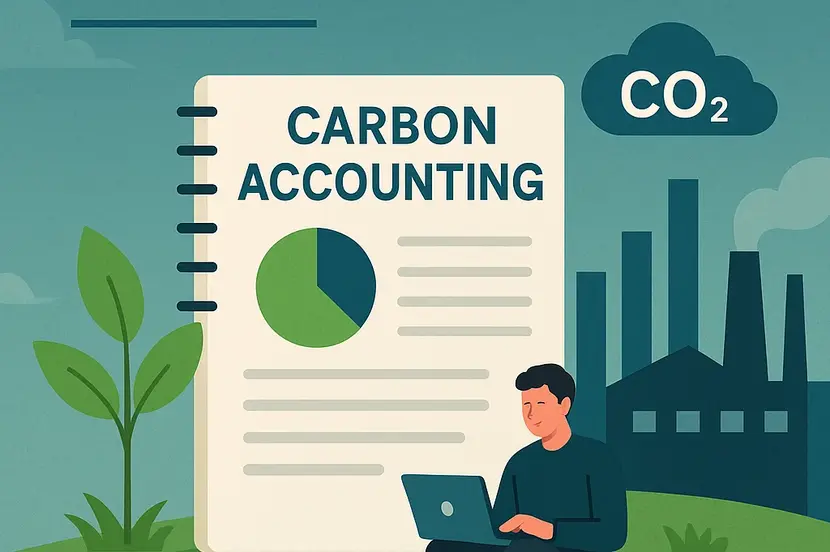As the rate of global warming intensifies, governments, businesses, and consumers alike are being compelled to minimize their carbon footprint. Carbon accounting, a mechanism for measuring and managing greenhouse gas (GHG) emissions, is among the most effective weapons in the campaign. No longer the exclusive domain of experts, it is now at the forefront of environmental policy as we approach 2025—a make-or-break year for the world’s sustainability targets.
Learn About Carbon Accounting
Greenhouse gas accounting, or carbon accounting is the practice of tracking the level of carbon dioxide (CO₂) and other GHGs that companies are releasing. Similar to how financial accounting tracks revenue and costs, carbon accounting tracks emissions so companies know where they are generating emissions and how to lower them.
It comprises Scope 1 direct emissions quantification, Scope 2 indirect emissions of purchased energy used, and all other Scope 3 indirect emissions along the value chain. It extends from employee travel to supplier-driven emissions and end-of-life product disposal.
Today’s businesses are relying increasingly on sophisticated tools and platforms to perform this daunting task. Greenly is one such tool that provides science-based automatic calculation of the carbon footprint, making it easier and accurate.
Why Carbon Accounting Is Relevant in 2025
1. Regulatory Pressure
Governments across the globe are implementing stringent climate rules, forcing carbon disclosure. The European Union’s Corporate Sustainability Reporting Directive (CSRD) is forcing thousands of companies to disclose enormous sustainability data, such as carbon emissions. Likewise, the United States Securities and Exchange Commission (SEC) is forcing climate disclosure regulations that will affect listed companies.
Reporting on carbon isn’t an option by 2025—it’s mandatory. Not reporting rising emissions and reporting incorrectly can lead to lawsuits, financial penalties, and reputational damage.
2. Investor and Consumer Demand
Sustainability is no longer an issue of compliance but a market expectation. Investors are increasingly calling for increased transparency over environmental performance, and ESG data is driving more capital than ever before. Customers are also making value-based purchasing decisions, selecting brands that are leaders in climate stewardship.
Carbon accounting allows organizations to deliver these requirements not just as a compliance exercise but to report credibly and reliably on their climate action.
3. Risk Management and Competitive Advantage
Carbon accounting reveals supply chain risk and inefficiency. Businesses, for instance, can spot high-carbon transportations or suppliers and replace them with lower-carbon alternatives, often at reduced expense. It also enables businesses to pre-plan and insulate themselves from carbon charges or climate-related shortages of materials.
Further, mission-driven businesses are able to pay premium talent, particularly younger generation employees looking for meaningful workplaces.
How Carbon Accounting is Conducted
Carbon accounting can be conducted manually, but since the process is time-consuming and there is much data involved, most organizations opt to utilize computer software for ease and accuracy. These platforms, like Greenly’s carbon footprint solution, integrate finance and operational data so that emissions can be automatically calculated for all scopes.
The procedure usually involves:
- Data Gathering: Collection of information from energy bills, travel records, supply chain data, etc.
- Calculation of Emissions: Utilization of industry-accepted emission factors for translating data into CO₂ equivalent (CO₂e).
- Analysis and Reporting: Determination of high-emission areas and generation of reports for regulators and stakeholders.
- Planned Reductions: Development of ways to reduce emissions, i.e., switching to renewables or product development.
These capabilities also allow for comparison of performance to industry peers and facilitate setting and monitoring science-based targets.
Carbon Accounting in Practice: Real-World Impact
With such large numbers of different types of businesses, ranging from technology companies to manufacturing companies, that have adopted carbon accounting into their processes, there are several examples that exist in the real world. International brands, for example, are employing it to monitor the carbon footprint of their individual products and make well-informed decisions on raw materials, packaging, and transportation.
Carbon accounting reduced emissions by 20-40% within a couple of years in some instances. Others have been exposing hidden inefficiencies that resulted in environmental benefits and cost savings.
Even small and medium-sized businesses (SMEs) are not celebrating with cheap platforms such as Greenly, offering customized solutions for various firm sizes and sectors.
Challenges and Way Forward
As needed, however, it does bring difficulties to carbon accounting. Gathering data can be challenging, particularly for Scope 3 emissions of upstream and downstream activities beyond direct control. Standardization of methods is also an ongoing process, although initiatives such as the Greenhouse Gas Protocol are assisting.
Another area of concern is “greenwashing,” when companies overstate or mislead regarding action taken towards enhanced sustainability. Accurate accounting of carbon on third-party sites has the influence of deterring this by making available verified, auditable information.
Emerging technologies involving AI, IoT, and blockchain can potentially enhance carbon tracking even further in the future to be even more precise and real-time and to integrate sustainability entirely into business-as-usual processes.
Conclusion
As 2025 rolls around, carbon accounting is the basis of real climate action. It gives companies the visibility they require to get ahead of changing regulations, satisfy stakeholder demands, and genuinely cut their mark. In doing so, it releases not only a better world but also smarter, more sustainable companies.
Whether you’re a multinational corporation or an emerging startup, integrating carbon accounting into your strategy is no longer a choice—it’s a necessity. Solutions are helping organizations of all sizes take this essential step toward a more sustainable future.




